










Website designed and maintained by KOR Communications
© Lower Otter Restoration Project






Queen’s Green Canopy

The Environment Agency, on behalf of the Lower Otter Restoration Project, has been granted a virtual plaque after planting 225 trees to form part of the Queen’s Green Canopy which marked the 2022 Platinum Jubilee.

Sign up for news from conservation trust
2 January 2024: After a fascinating journey over the past few years, we are pleased to be able to say that the construction phase of the pioneering Lower Otter Restoration Project is now complete.
As a result, this website will no longer be updated, but it is our intention that it should remain available online as a publicly available source of information until the end of 2024.
To comply with data protection legislation, the project mailing list is being deleted as no fresh updates will be issued by this route.
The Lower Otter is now being managed by the Pebblebed Heaths Conservation Trust and you can sign up for their newsletters here.
You can still email the project team and your message will be passed to the most relevant team member for a response.
On behalf of the whole team we would like to thank all those partners and members of the public who have supported us in this challenging and important project which has led to the creation of 55ha of fantastic intertidal habitat, benefiting wildlife and the community.
Residents celebrate opening of the 'Elizabeth Bridge'
24 November 2023: The brand new 70m "Elizabeth Bridge" has been officially opened by Hon. Charles Fane Trefusis and Mark Rice, Environment Agency Area Director, marking a significant milestone for the project.
Click here to read more.

Latest updates

Q&A
Answers to the most frequently asked questions about the project are available here.


Environment

Environmental Statement
To see the Lower Otter Restoration Project Environmental Statement, click here.

Public footpaths open, and cricket pitch work starts
May 25, 2021: We are currently revising the programme of work on the Lower Otter Restoration Project following our decision to postpone until this autumn vegetation clearance that might cause disturbance to nesting birds.
Whilst we are working with our team to re-
Clinton Devon Estates were granted planning permission last year to move the cricket club from its current flood prone site at Ottermouth as part of the Lower Otter Restoration Project. The new home for the club will be a 3.5-
Elsewhere, all public footpaths are open and traffic management signage across the site will be removed until the main scheme commences. Parking restrictions along South Farm Road will be lifted and the bollards removed, except to the east of White Bridge where they will remain in place to prevent vehicle damage to the Site of Special Scientific Interest (SSSI).
The Lower Otter Restoration Project will work with nature to manage the Otter Estuary and its immediate surroundings in a more sustainable way. We will share our revised programme as soon as we can.
Work starts on site on key elements of Lower Otter Restoration Project
June 29 2021: We are pleased to confirm we are starting on-
Over the next few weeks the Environment Agency's contractor Kier will set up the main site compound and offices in a field adjacent to the junction of Granary Lane and South Farm Road.
From 12 July lorries will start bringing resources to the site including clay material for the construction of the raised new road embankment. This clay material will initially be stockpiled next to the site offices.
Due to construction traffic parking restrictions will be in operation along South Farm Road. We apologise for any inconvenience during this activity. Private and site vehicles travelling to Lime Kiln Car Park will be directed via the main road using diversion signs.
In August we will begin excavating a new system of tidal creeks between Big Bank (towards the northern end of the project area) and South Farm Road. This will include creating access points and tracks for the machinery. This work will be done without vegetation clearance being required.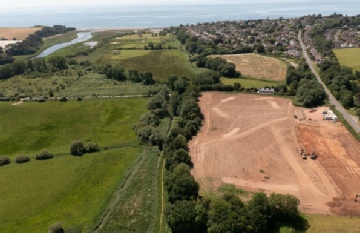
Throughout the summer Kier will continue with the cricket pitch at Budleigh Salterton Cricket Club's new location just off the B3178 East Budleigh Road. This work began a few weeks ago and is progressing well as you can see from the photo here.
During this autumn we will be carrying out the main vegetation and tree clearance around the site, including at the old tip on South Farm Road (this is the work postponed from May).
Throughout construction we will keep working very closely with our ecologists, the RSPB and other organisations to ensure wildlife disturbance is minimised. This will be delivered through our revised schedule, the provision of adequate buffer areas for the works and ongoing monitoring.
Our revised programme is:
- Summer 2021 -
cricket pitch construction, main site compound set- up, soil imported, start of work on the tidal creek system north of South Farm Road - Autumn 2021 -
main vegetation and tree clearance, start of new South Farm Road, western side of new bridge structure - 2022 -
embankment earthworks, creation of tidal creeks south of South Farm Road, road and bridge construction, footbridge construction. - Spring 2023 -
completion of the Lower Otter Restoration Project.
Footpath temporarily closed as work continues on Lower Otter Restoration Project
August 23, 2021:
- West footpath will close on 1 September for eight weeks
- Vegetation clearance and creek creation work about to start
- No parking still operating on part of site
A popular footpath on the lower Otter estuary will be closed for several weeks as vegetation clearance and the creek excavation stage of the work gets under way.
The work is part of the Lower Otter Restoration Project in Budleigh Salterton, which will see land reclaimed from the sea 200 years ago being returned to floodplain.
Work to excavate creeks on the northern end of the site starts on Tuesday, 31 August and will take five weeks. On Wednesday, 1 September, vegetation clearance will begin and is expected to take six to eight weeks, and is being timed to be after bird nesting and dormice breeding seasons.
In order to keep people safe, the west footpath will be closed from 1 September for eight weeks. This is the footpath near the top point of Budleigh Salterton Cricket Club's pitch and the first one reached when coming down South Farm Road from East Budleigh Road. The eastern footpath will remain open from South Farm Road to the L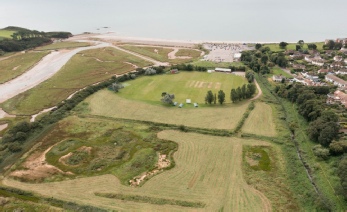 ime Kiln car park.
ime Kiln car park.
It may also be necessary to prevent access to wildlife viewing platforms for short periods during the work, but marshals will be on hand to let people know if platforms are temporarily closed.
No parking is operating in South Farm Road and at Whitebridge throughout the project works, which will continue until spring 2023 when a new car park will be built off South Farm Road.
The project is part of the €26m Promoting Adaptation to Changing Coasts project, which also has a similar scheme under way in the Saâne Valley in Normandy, France. In Devon it will see current grassland created during historic reclamation work, replaced with 55 hectares of intertidal mudflat and saltmarsh, plus a net gain of more than 2 hectares of broadleaved woodland and 1.5km of hedgerow.
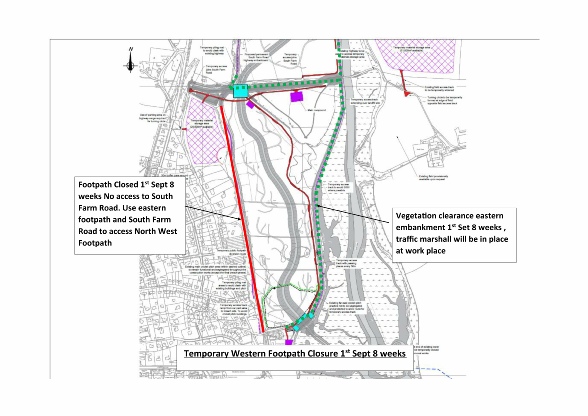
Marshals to help pedestrians during clearance works
September 24, 2021: An update to the Notice of Planned Work has now been displaying in all boards on the river Otter this week.
This includes advance warning that from Monday 27 September, the eastern footpath north and south of South Farm Road (Otterton footpath 1) remains open, but where vegetation clearance works will be very near to the path, marshals will direct pedestrians asking them to wait for their own safety until it is safe for them to continue.
Statement following flooding at project site
October 21, 2021: Following overnight flooding at the Lower Otter Restoration Project site, the Environment Agency has said:
"The Lower Otter Restoration Project is a partnership project seeking to adapt the downstream part of the River Otter in the face of rapidly changing climate, by connecting the Lower River Otter to its historic floodplain and creating intertidal habitat. This flooding is an example of what will happen increasingly as a result of climate change. It is an entirely natural phenomenon and has not been caused or exacerbated by project works.
"Flood waters from the River Otter rose sharply shortly after midnight peaking at 3:30am. This inundated some construction plant. We are working with our contractor, Kier, to understand why this was not moved ahead of the flooding. Plant will be moved as soon as is possible.
"Currently, flood waters resulting from heavy rainfall are unable to drain quickly in the valley due to the presence of an embankment that traps the water behind it. One of the benefits of the Lower Otter Restoration Project is that, once completed, the River Otter will be reconnected to its floodplain and the sea resulting in improved drainage.
"Once the project is in place, floods of this level will no longer sever access along the South Farm Road, flood the cricket club or threaten a former tip site to the same degree. Areas of footpath will also be raised above existing levels.
"The impact of this flooding highlights the need to adapt to climate change by moving human infrastructure out of the floodplain and make what remains more resilient to flooding. This is a key aim of the Lower Otter Restoration Project.”
The floodwater has subsided and South Farm Road is open again
October 28, 2021: The Lower Otter Restoration Project (LORP) is a partnership project seeking to adapt the downstream part of the River Otter in the face of rapidly changing climate, by connecting the Lower River Otter to its historic floodplain and creating intertidal habitat.
The flooding last week is a dramatic example of what will happen increasingly as our climate changes. It is an entirely natural phenomenon and was not caused or exacerbated by the LORP project works.
As soon as the floodwater started to subside our contractors moved the equipment and vehicles. Most machines could be restarted and driven out of the floodwaters when water levels allowed. South Farm Road is now open and has been swept clear for residents and access to South Farm businesses as usual.
Environment Agency pollution staff closely monitored the site clear up to ensure that the river has not been adversely affected following the flooding. We are pleased to confirm that no material pollutant release was identified.
We are working with our contractor to learn from the event and understand why the construction plant was not moved ahead of the flooding. We are already making improvements to ensure this does not happen again at LORP or any of our other sites.
Our programme of works is being revised following the flooding, recovery and clean-
When complete, in spring 2023, this important climate change adaptation project will reconnect the river to its floodplain and the sea resulting in improved drainage. Floods of this level will no longer cut off access along South Farm Road, flood the cricket club or threaten the old tip site to the same degree. Areas of footpath will also be raised above existing levels.
Northern creek network at Lower Otter site nearly complete
o Northern creek network largely finished
o Channels are reconnecting to historic floodplain
o The work is creating new wildlife habitats
November 30, 2021: Work to create creeks to the northern end of the Lower Otter Restoration Project site is now nearly complete.
Excavation of the network at the northern end of the site -
Together, the total excavated length of the creek network already exceeds 3km. These will evolve naturally over time once connected to the Otter. One of the islands on the floodplain is also nearing completion, this will act as a refuge for birds at high tide.
Dan Boswell, Environment Agency project manager for the site, said: "When the creeks are all complete we will have a network that will reconnect the estuary to its historic floodplain.
"The creeks will be the 'veins' of the estuary, bringing new life to the valley floor, attracting a wide variety of wildlife to the wetland habitat and enabling floodwater to drain down more quickly."
The Lower Otter Restoration Project is part of the €26 million Promoting Adaptation to Changing Coasts project, which also has a similar scheme underway in the Saâne Valley in Normandy, France.
In Devon. it will see current grassland created during historic reclamation work replaced with 55 hectares of intertidal mudflat and saltmarsh, plus almost three hectares of broadleaved woodland and 1.5km of hedgerow.
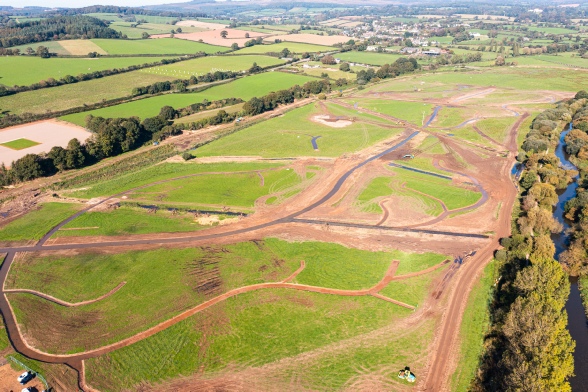
Noisy work and holiday break
December 14, 2021: To prepare for the construction of the new 40 metre long South Farm Road bridge, we are installing steel sheet piles to retain soil on the corner of the former tip, adjacent to South Farm Road. This is so that we can excavate the ground in preparation for the construction of the road bridge piers.
Unfortunately, piling is an activity which can be noisy, although we are doing what we can to minimise the impact on local people, visitors and businesses. The sheet piling starts this week and will last 3 weeks in total. However, all planned construction at the site will stop over Christmas and New Year from 23 December and restart Tuesday 4 January 2022.
There are also some ground investigations being carried out by South West Water in the south east area of Lime Kiln car park. These will last for approximately 6 weeks from the beginning of December.
If you have any questions or concerns about the site works, please do not hesitate to contact Kier's public liaison officer either by email at exmouth.PLO@kier.co.uk, or mobile on 07716 223056.
Stakeholder Update -
January 21, 2022: ON SITE: 2022 has started well on the main Lower Otter Restoration Project (LORP) construction site.
The steel sheet piling is complete and excavation to enable construction of the piles and piers of the new South Farm Road bridge has started. The waste material removed from the old landfill site is being taken away for treatment and recycling.
Vegetation clearance and tree removal on the old tip is nearing completion. Large stands of the invasive plant Japanese Knotweed have been removed -
We continue to bring in and stockpile material for the construction of the new South Farm Road embankment.
The new 40 metre span road bridge near South Farm Cottages will start to take shape with foundation piles constructed during February and March, and the piers being constructed during April to June. From April onwards we will start to build the embankment for the raised South Farm Road and other activities including excavating the southern creek network.
South Farm Road will be raised by 2.5 metres above the floodplain delivering significant long-
During the summer we will be lowering Big Bank and Little Bank and excavating the new channel for the Budleigh Brook.
Towards the end of 2022 the new embankment will be connected to White Bridge over the River Otter (White Bridge will not be altered). A short section of temporary private road will be used for all vehicles that currently access the east-
CRICKET CLUB SITE: The new cricket pitches are ready. Budleigh Salterton Cricket Club has redesigned the club house and expects to submit new plans to East Devon District Council (EDDC) by the end of this month.
SEWAGE OUTLET: As part of the LORP, South West Water hopes to renovate the old, combined sewage outlet that runs behind the shingle bar from Lime Kiln car park to Otter cliffs.
This ageing pipe is exposed sometimes and at risk from erosion. It also represents above ground hard engineering that we don't want associated with the shingle bar. In LORP the combined sewage outlet will be taken underground. Preparatory investigations are being carried out in Lime Kiln car park and on the cliffs at South Farm.
WILDLIFE: More wading birds and wildfowl are already being seen using the newly created freshwater habitats to rest and feed. When the embankment is breached next year saltwater will ebb and flow back into the lower valley. The rare and nature-
FOOTPATHS: Devon County Council and Clinton Devon Estates are discussing potential long-
Although the affected sections of footpath are outside of the LORP site boundary, the erosion is being monitored due to its potential impact on the project and contingency plans are in place if conditions deteriorate.
A planning amendment for the southerly section of the western footpath (between Lime Kiln and South Farm Road) will be submitted to EDDC by the Environment Agency in April. This was part of the delayed FAB Link project and the design will be broadly the same as FAB Link’s approved but now lapsed planning permission. This will reduce the flooding of the footpath and provide an improved path surface. We will share the design details in due course.
If you have any questions or concerns about the site works, please do not hesitate to contact Kier (the Environment Agency's contractor) either by email at exmouth.PLO@kier.co.uk, or mobile on 07716 223056.
Stakeholder update -
March 9, 2022: Since our last update the Lower Otter Restoration Project (LORP) featured on BBC Countryfile as part of a special programme on Clinton Devon Estates. As well as super publicity it was a perfect opportunity to show a national audience the key benefits to wildlife and people that LORP will deliver as the Lower Otter Valley adapts to climate change.
And, if you can access You Tube, look at Promoting Adaptation to Changing Coasts -
ON SITE: The LORP site team led by Kier has been making good progress since our last update.
You may well have seen the huge blue machine on the site. The auger with its giant corkscrew is part of the specialist equipment being used to construct the reinforced concrete foundation piles for the new 30-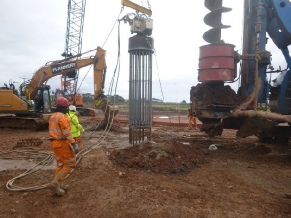
At the same time we will start construction of the embankment to carry the new South Farm Road. Once completed, the realigned road will be up to 2.5 metres above the floodplain. To help you visualise it: the final level of the new South Farm Road will be on the same level as the current road level at White Bridge. No changes are being made to White Bridge itself.
However, please be aware that to achieve the final 2.5 metre height of new South Farm Road it is necessary to temporarily ‘over-
Towards the end of the year the new embankment will be connected to White Bridge before it crosses the River Otter. While the new road is being built and connected all vehicles will use a short section of temporary private road providing access to the east of the river with minimal disruption.
Meanwhile, material for the embankment is continuing to be brought in and stockpiled. At the end of March this will total 9,000 m3.
VEGETATION AND WILDLIFE: A small amount of remaining vegetation, mainly bramble on the eastern side of the old landfill site next to South Farm Road, will be cleared during the next couple of months. This is the material previously cut to 30cm high to safeguard any hibernating dormice. This second stage cut will be down to ground level.
Our site team is taking the utmost care to reduce LORP impacts on wildlife. We will continue to have a team of ecologists working on site with us to check for signs of dormice and nesting birds. We are not planning to fell any more significant areas of trees and are now look forward to the substantial programme of tree planting next year. Our ecologists have found that the existing site supported less wildlife than we anticipated. We believe the move to a more natural system with a greater number of native trees will bring a significant increase in diversity and numbers of wildlife to the site.
PUBLIC ACCESS: Next month the Environment Agency will be submitting a planning amendment application for the popular southerly section of the Western Footpath (BS-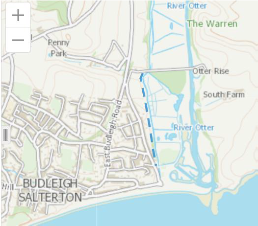
This raised footpath construction was to be delivered by the FAB Link project, but due to delays on that project, the planning permission has now lapsed. LORP will now do this work and the design will be broadly the same, increasing the level and improving the surface. This will reduce the flooding of the footpath and provide better future access suitable for all users.
As soon as the application is accepted by East Devon District Council (EDDC) we will let you know, with the relevant planning reference for the consultation. We expect EDDC’s decision in mid-
Please note in late April 2022 we will start raising the north section of the Western Footpath (ref: East Budleigh PROW 3) between South Farm Road and Big Bank. A footpath closure from April to July will be required to carry out these works.
FORWARD LOOK: During the summer we will be lowering a 170-
Toward the end of the summer there will be a focus on the old landfill area. This will include capping, erosion protection, landscaping and building a public footpath across an area previously inaccessible to the public.
Between October 2022 and March 2023, a new pedestrian footbridge will be built just behind the estuary embankment. This bridge will carry the South West Coast Path once the 70-
Please note -
PUBLIC ENGAGEMENT: The LORP Liaison Group met earlier this month. The aim of this group is to give local councillors and other contacts up to date detail about the project works to help them provide information and reassurance to their communities. The notes from this group are available here on the LORP website.
There is also a busy programme of school visits and talks. In the coming months we will be offering guided LORP site visits -
Visit the new KIER@LowerOtter Facebook page for the most up to date construction information, and if you have any questions, concerns or feedback about the site works, please do not hesitate to contact Kier (the Environment Agency’s contractor) either by email at exmouth.PLO@kier.co.uk, or mobile on 07716 223056.
Lower Otter Restoration Project saves rare plants from sea level rise
March 18, 2022: Some of Devon's rarest plants are to be moved to new sites in the county on Tuesday as work continues on the Lower Otter Restoration Proje ct (LORP).
ct (LORP).
The Lower Otter is currently the only known place in Devon where the divided sedge (Carex divisa) is found and is one of only a few sites in the South West where it grows -
Also being moved are some populations of galingale (Cyperus longus), which is also scarce nationally, though less so in Devon than the divided sedge. Unlike the divided sedge, the galingale will be able to continue to survive in some areas of the lower Otter valley.
Three sites with similar ecological characteristics have been chosen to replant these rare species and their progress will be monitored over the next 12 months. One of the chosen sites is grazing marsh associated with the Axe estuary, where divided sedge had been known to grow but was last recorded as present in 1934.
Moving the rare plants follows on from 400 southern marsh orchids that grew on the Lower Otter being relocated elsewhere last year.
Dr Sam Bridgewater, Head of Wildlife and Conservation for landowners, Clinton Devon Estates, said: “The divided sedge is an unassuming little plant which you could be forgiven for overlooking, but it's the rarest living thing that the LORP scheme will provide help to. We hope it will thrive in the new sites it is to be moved to.”
 This week also saw planting of hedgerows to the north of Little Bank begin. Native species, including hawthorn, blackthorn and dog rose, have been planted in among gaps to existing hedgerows. The LORP project will see a net gain of 1.5km of hedgerow when completed.
This week also saw planting of hedgerows to the north of Little Bank begin. Native species, including hawthorn, blackthorn and dog rose, have been planted in among gaps to existing hedgerows. The LORP project will see a net gain of 1.5km of hedgerow when completed.
The Environment Agency led LORP project is one of two schemes under the ERDF’s Interreg France Channel England funded Promoting Adaptation to Changing Coasts project. The second site of the total €26m project is in the Saâne Valley in Quiberville, Normandy.
Fairlynch Museum to host Lower Otter Restoration Project exhibition
April 4, 2022: Budleigh Salterton’s Fairlynch Museum is to host a two-
Funded by the Environment Agency, the East Devon Area of Outstanding Natural Beauty (AONB) Communities Project Fund and Lord Clinton’s Charitable Trust, the exhibition will be opened by Lord Clinton at 7pm on Thursday 14 April.
The exhibition features a specially commissioned video which will play out on a large screen, plus information boards on the project covering the history, flooding, wildlife and archaeology of the estuary, the aims of the project, its funding, climate change and looks at objections to the scheme.
Chair of the Fairlynch Museum, Trevor Waddington OBE, said: “Without doubt the Lower Otter Restoration Project is the most significant event in the River Otter estuary for over 200 years. 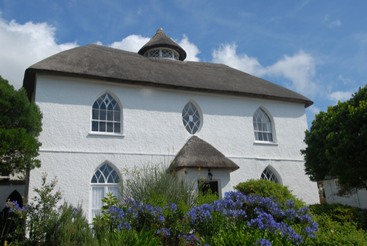
“The work is planned to complete in 2023 and Budleigh Salterton’s Fairlynch Museum exhibition for the next two years will present the many aspects of the project in an imaginative way. Education is a primary purpose of the museum and we are delighted that a programme of visits by children from local schools has already been planned.”
Mike Williams of the Environment Agency, who has been working on the project for a number of years, said: “Everyone working on the project is very proud of the fact that it is to be highlighted in the town’s museum in this way. It will provide a record of the work for future generations.”
Manager of the East Devon AONB Partnership, Chris Woodruff, added: “Landscapes never stand still. They are constantly evolving and from time to time, mankind occasionally accelerates that process.
“The landscape changes happening as a result of the mitigation works in the Lower Otter Restoration Project are significant and far reaching and have not been without their challenges. This exhibition will help to explain the history of landscape change through the ages in the lower Otter and the modern-
“We are pleased to be able to support this exhibition with our Communities Project Fund.”
The Fairlynch Museum, a thatched, early 19th Century marine cottage orné in Fore Street, Budleigh Salterton, opens from Tuesdays to Sundays, plus Bank Holiday Mondays, from Easter until the end of October.
Picture courtesy of the Fairlynch Museum
New road embankment and bridge to start to take shape at Lower Otter next week
April 21, 2022: Building of the new road embankment and a 30m-
The concrete foundation piles for the bridge are now complete and building upwards will begin. This includes the construction of the piers and supports of the bridge (abutments) and the earth embankment for the road itself which will go across the valley parallel to the existing road. The embankment will eventually be 2.5ms higher than the current South Farm Road – the same level as the nearby White Bridge – lifting it above the level of the floodplain and making it more resilient to flooding.
 Dan Boswell, LORP project manager for the Environment Agency, said: “This is a fascinating opportunity to see civil engineering in action. Although it will look very big initially, after about four months the surcharged embankment will be re-
Dan Boswell, LORP project manager for the Environment Agency, said: “This is a fascinating opportunity to see civil engineering in action. Although it will look very big initially, after about four months the surcharged embankment will be re-
Towards the end of the year, the new embankment will be connected to White Bridge before it crosses the River Otter – White Bridge will remain unchanged. To minimise disruption while the new road is being built and connected, later this year a short section of temporary private road providing access to the east of the river will be built. The new bridge is expected to be completed during the autumn.
The project is part of the €26 million Promoting Adaptation to Changing Coasts project, which also has a similar scheme underway in the Saâne Valley in Normandy, France. In Devon it will see current grassland, created during historic reclamation work, replaced with 55 hectares of intertidal mudflat and saltmarsh, plus a net gain of more than 2 hectares of broadleaved woodland and 1.5 kilometres of hedgerow.
Footpath application
April 13,2022: We have applied for permission to carry out improvements to the western footpath between South Farm Road and Lime Kiln car park. Raising the footpath and resurfacing it will improve accessibility and reduce flood risk. This is similar to plans previously passed by EDDC for FABLink, which have since lapsed. More details can be found on the council planning portal.

Click for more news

Planning permission granted for footpath improvement work on Lower Otter valley
June 9, 2022: Work to raise the height of a popular public footpath west of the Lower Otter Restoration Project site is due to begin in August. The newly approved works do not affect the South West coast path.
The 900m long footpath to the west of the floodplain of the River Otter, which runs from the entrance to the existing Budleigh Salterton Cricket Club on Granary Lane to South Farm Road, will be raised by up to 1m to a consistent level. This will take it above the level of most tides, ensuring access is maintained in most circumstances.
FABLink had previously been granted planning permission by East Devon District Council to raise the footpath, but this had lapsed. The Council has now agreed to an amendment to the Lower Otter Restoration Project (LORP) planning permission to enable the Environment Agency to carry out these footpath improvements.
The work will result in an improved surface to the footpath, making it more accessible for people with mobility difficulties and more of an all-
If the footpath was not raised it would flood about 300 times a year. Raising it will reduce the number of times when the water is at or above the surface of the footpath to approximately 20 times in a year.
Dan Boswell of the Environment Agency said: “The footpath improvements should result in a safer, more accessible and all-
“I would like to thank footpath users for their patience with the footpath closure. We have wanted to minimise the impact of works on users of the valley, keeping footpaths open for as long as possible and providing alternative route during closures. Unfortunately, we have not been able to do this at this particular location and the footpath will need to remain closed for the duration of the LORP project work.”
The Lower Otter Restoration Project is primarily funded by the UK government, but also receives funding as part of the €26 million Promoting Adaptation to Changing Coasts project, which also has a similar scheme underway in the Saâne Valley in Normandy, France.
Say “Hello” to the Lower Otter Restoration Project
Visitors can use their mobile phones to find out more about the project.
Visitors to the area of the Lower Otter Restoration Project (LORP) can now have a virtual conversation to find out more about what is happening with the scheme.
The project has launched a 12-
Hello Lamp Post allows people to have two-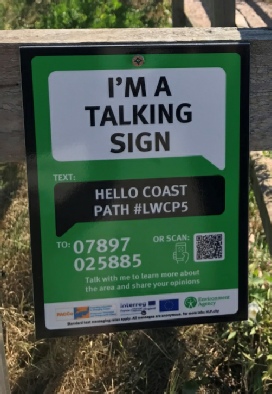
The first interactive locations are now live at the Lime Kiln car park, along the South West Coast Path, at the bird hide, on fingerposts, benches and viewing platform on the footpath and at the Kier Construction compound entrance in Granary Lane.
Mike Williams, project team member for the Environment Agency, the lead partner in the project, said: "Community engagement has always been a key part of the Lower Otter Restoration Project. We're always looking for new and better ways to talk to people, to find out what residents and visitors think of the work we're doing and to let them know why we're doing the work. Hello Lamp Post lets people reach us when they're walking by the project site."
The Environment Agency is working in partnership with landowner Clinton Devon Estates to deliver the £15m Lower Otter Restoration Project, which is due for completion next spring.
A similar project is taking place in Quiberville, Normandy -
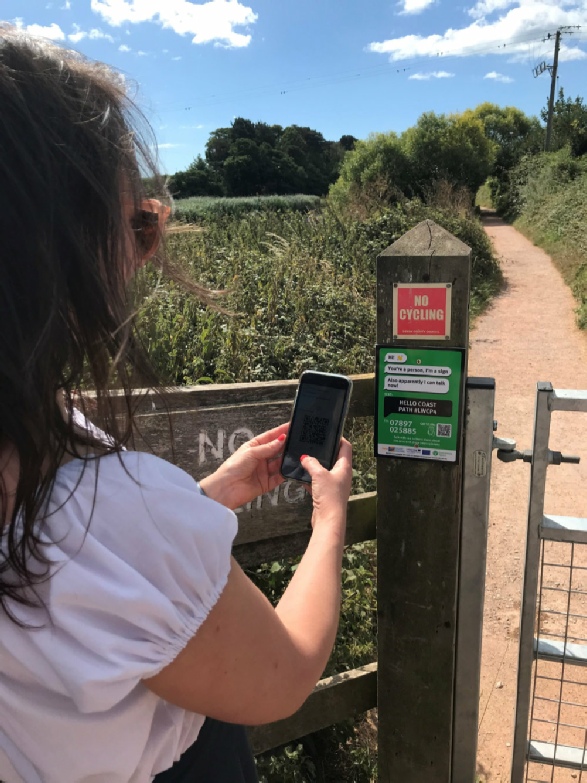
Night-
August 18,2022: As advised in previous communications, Kier have been constructing the new South Farm Road embankment to raise the existing road out of the floodplain. When complete this key element of the Lower Otter Restoration Project (LORP) will bring significant long-
The new road will be connected to White Bridge towards the end of this year. The simplest way to achieve this is to close a section of the existing South Farm Road, for an extended period, while work takes place. But to ensure you are not inconvenienced a short section of temporary private road will be built alongside the existing road.
Soon Kier will need to create tie-
- South Farm Road will be closed overnight between 8pm and 5am starting at 8pm Monday 5th -
and ending at 5am on Friday 9th September. We will re- open the road every morning at 5am. - South Farm Road remains open throughout the day and businesses are open as usual.
- The work is unlikely to be noisy and any heavy work will be undertaken before 11pm.
- Access through the closure for emergency vehicle will be maintained at all times.
- If you have any questions about this work and would like to speak to someone in person, please contact Kier's Project Manager Darren Davis via email: darren.davis@kier.co.uk or telephone: 07815 493 883.
Towards the end of 2022 South Farm Road will be closed again to enable work to be completed on the permanent road. This will also take place at night, with access opening up during the day. We will give you the exact dates and times when we have them.
New footbridge and cricket club to lead the next step of restoration at the Lower Otter
September 13, 2022: The next phase of the Lower Otter Restoration Project begins at the south of the site this September, with a series of access improvements to take place over the autumn.
The dry summer has seen the scheme progress well with significant progress made on preparing and consolidating the new raised and flood-
To ensure continuity of the popular and nationally important South West Coast Path, a 70-
While the footbridge works are underway, there will be a temporary diversion in place of a short section of the footpath. Dates will be confirmed, with more i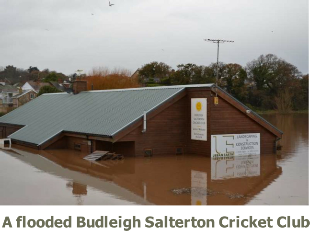 nformation to follow.
nformation to follow.
Starting work the same week after completing its final season, the nearby Budleigh Salterton Cricket Club will be relocated to its new home at an already constructed and purpose-
This means the existing clubhouse will be demolished and some surrounding vegetation within the floodplain removed by a specialist team of arboriculturists. Any trees lost will be replaced as part of the project's mitigation planting programme. This work will enable the creation over 50 hectares of rare wildlife-
Dan Boswell of the Environment Agency said: "Thanks to the continued support and patience of the local community and visitors to the Lower Otter, our work to reconnect the estuary to its historic floodplain for the benefit of birds, biodiversity and people is starting to take shape. The South West Coast Path and the cricket club mean a great deal to the community, and so it is important to us and the project that the project supports their future and helps them adapt to sea level rise.
"The temporary diversion of the footpath will allow users to continue to enjoy the area safely with as little disruption as possible, while the new footbridge and improved footpath will mean visitors will be able to take in better views all year round of the surrounding natural habitats and diverse wildlife that will be attracted to the restored wetlands. The new home of the relocated cricket club will not only safeguard it too from the risks of flooding, but will also allow for an even greater range of community amenities and activities."
The Lower Otter Restoration Project is an intertidal habitat creation project delivered by the Environment Agency in partnership with the East Devon Pebblebed Heaths Conservation Trust and Clinton Devon Estates.
It is part of a cross-
The Lower Otter Restoration Project has been majority funded by the UK government, with £8.5 million of co-
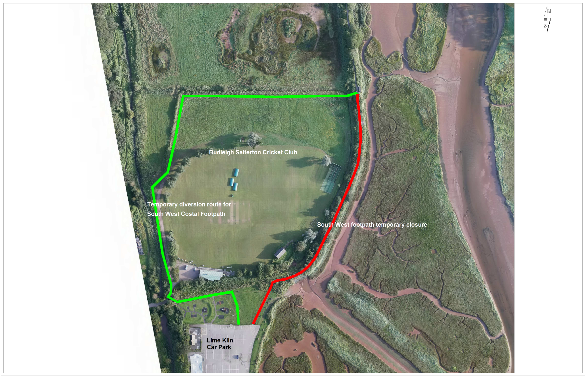
Temporary footpath diversion route: click image above to expand
Site progress
November 21, 2022: The project works have advanced well with significant progress made on preparing and consolidating the new raised and flood-
Work is now progressing at the southern end of the site, this is to enable the raising of the footpath in the west and the construction of the new footbridge on the South West Coast Path.
South West Water (SWW) will shortly commence works on the piped outfall between Lime Kiln car park and Otter Head. This means that from 21st of November until March of next year there will be two construction sites adjacent to one another.
We are conscious of the need to ensure that The Environment Agency worksite is coordinated with the SWW site to minimise the impact on the car park.
Both sets of works have been specially planned outside of the busier summer period and to have the smallest temporary working area possible, affecting the fewest number of spaces possible. The car park will remain open, and both play parks will remain available for use throughout. The South West Coast path on Otter Point will be unaffected.
Cricket Club: After completing its final season at the Ottermouth ground, the Budleigh Salterton Cricket Club has been relocated to its new more sustainable location. The replacement site provides improved facilities and is no longer subject to flooding.
The cricket club has chosen to build the clubhouse at the new site themselves, with substantial funding from the Environment Agency. You can keep up to date here: www.budleighcc.co.uk
The existing clubhouse has been removed and some surrounding vegetation within the floodplain removed by a specialist team of arboriculturists. The trees will be replaced elsewhere onsite as part of the project's tree planting programme.
Footpaths: We are pleased to have been able to reopen both the newly surfaced footpath between East Budleigh and the River Otter (which passes over Little Bank) and the footpath on the west of the valley between Big Bank and South Farm Road.
It will be necessary to close the footpath over Big Bank in the future when we link it to the new South Farm Road embankment, however, we wanted to make sure that people can use this route as soon as possible and therefore are opening it for the interim period.
It is worth noting that some sections of footpath may become impassable following heavy or prolonged rainfall and, once the estuary bank is breached, on some high tides. Please take note of the signs and boards that indicate the depth of water.
To ensure continuity of the popular South West Coast Path, a 70-
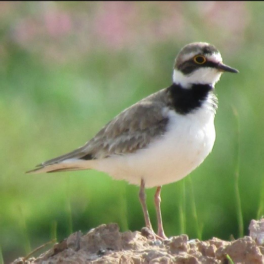 Birdlife: During the breeding season a multitude of species successfully bred and fledged young including mistle thrush and spotted flycatcher, both species have been absent in recent years. The newly constructed bird islands around the site are being topped off with pebbles (ideal plover nesting habitat) and raised by the project in order to make these areas even more attractive for them in future years Little Ringed Plovers have spent the summer in the Lower Otter. This schedule 1 species is not known to have stayed for so long in this area before and it is believed to have favoured this area due to the changes in habitat being undertaken as part of the project.
Birdlife: During the breeding season a multitude of species successfully bred and fledged young including mistle thrush and spotted flycatcher, both species have been absent in recent years. The newly constructed bird islands around the site are being topped off with pebbles (ideal plover nesting habitat) and raised by the project in order to make these areas even more attractive for them in future years Little Ringed Plovers have spent the summer in the Lower Otter. This schedule 1 species is not known to have stayed for so long in this area before and it is believed to have favoured this area due to the changes in habitat being undertaken as part of the project.
Budleigh Brook: You may well have noticed that the concrete aqueduct has been removed from the floodplain. Whilst this was a local landmark, the removal of the aqueduct represents a real win for wildlife. Having the Budleigh Brook held in a straight concrete channel on stilts (the former aqueduct) cut the brook off from the River Otter and dramatically reduced its ecological value to fish, invertebrates and birds. With the brook now back in the historic flood plain we expect this section of the brook to begin to improve ecologically.
Public engagement: In September we started offering monthly guided tours of the site, the first three have been well attended. The tours, which are on the afternoon of the second Tuesday in the month, last between three and four hours and involve a walk of around 5km / 3 miles. They are free but places need to be booked. We will advertise details of the fourth tour shortly. Keep an eye on the LORP website and the ‘Kier at Lower Otter’ facebook page for information.




